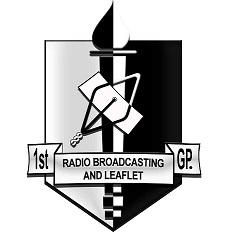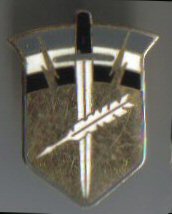

The Ganders
UNIT DECORATIONS:
History records that the 1st Radio Broadcasting and Leaflet Battalion and the 1st Loudspeaker and leaflet Company were the only PsyOp units to participate in the Korean conflict..
Although some military historians may question the relationship of the 1st RB&L to the 7th PsyOp Group, the evidence presented in the 7th Unit History, clearly demonstrates that at least the command structure of the 1st RB&L was reorganized to become Broadcasting and Visual Activity (14th RB&L and 14th PsyWar Bn's), the predecessors of the 7th PsyOP Group.
The 1st RB&L was formed in 1950 from the Special Projects Branch of Military Intelligence Far East Command...This command was redesignated as the Psychological Warfare Section in 1951. The 1st RB&L existed for only the war period in this command and was deactivated in 1954.
The First Radio Broadcasting and Leaflet Battalion made up of the 4th Mobile Radio Broadcasting Company and the 3rd Reproduction Company activated at Fort Riley, Kansas, November 8, 1950, arrived in Japan in August 1951 to take over the conduct of psychological operations from the psychological Warfare Section, which, after its arrival, was responsible for planning and supervising psychological operations.
During the Korean War, Voice of the United Nations Command (VUNC) broadcast in Korean, and in Mandarin and Cantonese dialects (after Chinese intervention) were carried over leased radio facilities in Japan which could cover all of Korea and parts of Manchuria and central China.During the war, it was estimated that over two and one-half billion leaflets were disseminated against the enemy.
As an operational unit, the 1st RB&L was under command of the Far East Psychological Warfare Section...In 1956 two years after the deactivation of the 1st, the Far East PsyWar Section was redesignated as U.S. Army Broadcasting and Visual Activity. (Designation used by 14th RB&L and 14th PsyWar Battalions)
The 7th PsyOp Unit History also reports that some of civilian employees of the 1st RB&L remained as part of the 14th PsyWar Battalions and eventually the 7th PsyOp Group:
To assist in producing leaflets and radio broadcasts in Korean and several Chinese dialects, a number of korean and Chinese people were hired as announcers, translators, and writers. These people worked mostly for the First Radio Broadcasting and leaflet Battalion.. It should be noted that many of these people are still with the 7th PsyOp Group today (1967), and that they possess a long and valuable experience in psychological operations.

The present day 4th Psychological Operations Group records that the 1st RB&L was later reorganized in 1960 at Ft. Bragg and continues as the 1st Psychological Operations Battalion:
Historical evidence however shows that the 1960 reorganization of the 1st RB&L is an example of a reuse of a unit designation since the command structure of the 1st RB&L was reorganized into Broadcasting & Visual Activity in 1956.
On 3/7/07, Bill Ryder discussed (e-mail) his tour with the 1st RB&L at Ft Bragg in 1960. His mail reminded me that I was contacted earlier by Bob Richards who said he was also with the 1st RB&L at Bragg prior to his tour of duty with VUNC (14th PsyWar Bn) in Korea. I was at first confused by these statements considering that the 1st RB&L was supposedly deactivated in 1954 following its participation in the Korean War.
Rereading Ryder's mail a second time revealed the 1st RB&L at Bragg was a redesignation of the "3rd Radio Broadcasting Company" and the "4th Loudspeaker & Leaflet Company" in 1960. This information supports the reasoning that the 1st RB&L at Bragg was not the same unit as the 1st RB&L of the Korean War and predecessor to 7th PsyOp Group... Evidently the reuse of unit designations is not uncommon. See example in which the 24th PsyOp Detachment was used for two different units in Korea and Vietnam. ( History of 24th Detachment).
In summary, although the present day 1st PsyOp Battalion of the 4th Psychological Operations Group cites the 1st RB&L of the Korean War in its lineage, in reality the command structure of the 1st RB&L became B&VA and ultimatley the 7th Psyop Group. The reorganization of the 1st RB&L in 1960 at Ft Bragg was a reuse of a unit designation.
For a more detailed account of the history of the 1st RB&L in the Korea War see the PsyWarrior
See also new Account Page of members who served with the 1st RB&L.
Since the 1st RB&L is historically part of the lineage of the 7th PsyOp Group, accounts, historical documents and list of personnel from the Korean War unit will be included on the PsyOP page.
Bill Keenan who served with the 1st RB&L during the Korean War sent me some pages from a booklet entitled "Life and Times" of the 1st RB&L which I had posted previously.
Frank Sass contacted me 7/24/2007
I was a member of this group from about June 1951 until I was discharged in January 1953. I moved with the group from Ft Riley to Tokey and was stationed in Tokyo as part of the Headquarters group under WO Phil Casias. I was a Corporal and a Clerk Typist, and as such typed many of the English translations of leaflets dropped over North Korea. I still have copies an many of them as well as the complete Yearbook described in your on-line writeup. I also have a complete roster of 1st RB&L personnel with home addresses. I will provide you with copies of these two documents if you wish.
I expect the information contained in "Life and Times" is rare so pages received from both Bill and Frank are posted below. The personnel roster including 253 names has been added on the Organizational Page.
Although Frank Sass provided entire booklet, I kept first few pages provided by Bill Keenan. The print on these first pages and pictures was not readable so I retyped each page below. Click on appropriate hot spots for pictures..
 |
|---|
Cover Page dated June 1952
With no predecessor for guidence, dapper, personable Homer E. Shields (Col) carefully directs the destiny of one of the most talented and unique organizations in the service. From the difficult formative days at Fort Riley, through the trying situations of full-scale operations in the Korean War, the Group has slowly, but surely planted its feet on solid ground. Ably guided by the Colonel, it has blossomed into a well-knit highly productive unit.
The Colonel's cheery, booming "hello" remains a trademark, though many times his young struggling organization is a tempermental problem child. Himself a veteran of psywar in Africa and Europe during World War II, the commanding officer is plenty proud of his psywarriors.
Forming the second half of the team in the front office is wiry, well mannered William H. Buckley. The slight, sandy-haired executive officer exudes tact and personality plus in carrying out his duties. A perfect straight man for the CO's numerous gags, "Buck" is a World War II ex-battalion commander in the 104th "Timberwolf" division in Europe. In his office, his ready grin and twinkling eye make quick friends with the stranger. A self styled public relations man, the Major travels many miles with the inevitable result of making many new friends for the Group.
This is a story about a building, a sign, a bunch of guys and a very proper gander (which disappeared someplace along the way).
We all know wars are supposed to be spaced twenty years apart these days. But the timetable went haywire in 1950 and we found ourselves with a fight on our hands in Korea. It turned out to be a big tussle. It called for the full treatment...tanks, infantry, planes and something called psychological warfare. That's where the building, the sign, the gander and the guys fit in...in an experimental psywar outfit with the wierd name of "The First Radio Broadcasting and Leaflet Group" .
The Building
|
|---|
The Fighting First existed only on paper in a Pentagon outbasket until December, 1950. Then, in a ponderous, army way, the First began to take shape at Fort Riley, Kansas, in a vast stone pile labelled Building 39
The Sign |
|---|
The first arrival was a reserve master sergeant from Denver, Phillip Casias. He filled out morning report number 1 on December 17. After that the floods came. Tidal waves of high striped reserves, officer, rivers of sleeve-bare draftees, a thin stream of RA's and a trickle of guardmen crowed into Building 39.
Then, the First plodded through a series of classes, marches and moves, fled a flood and battled seasickness. finally, in August, 1951, it arrived in Yokohama and spread over Japan and Korea. It was in business at last. The business of spreading the word.
The word was tri-valent. In the chemistry of the brain it twisted and became different, according to the skin of the man it reached and the slant of his eyes and the piece of earth called home.
It was a word and a weapon. It was cruel, cutting, humane, merciful. It was many things. But above all, it was the chance....the door to peace, not war. The only way outside of a bullet to probe the innards of a skull. the only way to reach inside that man across the battle-lines and say, "Look, I'm your friend. I don't want to kill you. won't you listen to why I fight?"
If the word was used right, it meant a million lives....if wrongly, a million deaths. The tongue and quick wit of man spawned it. The word would no die. It must be used to win or lose a war.
On battlegrounds the word was spread through loudspeakers |
|---|
The word was English and then it was split like an atom into Korean and Chinese. It started in Tokyo.... as radio waves and in the hinged bellies of B-29's, it traveled the tense and turbelent air. it found strange resting places with outlandish names, like Pyongyang, and Hambong and Peiping. It changed numerous minds ...perhaps; it saved many lives.....maybe; it caused misunderstanding.....certainly. For better or worse, the word remained.....and some said those who used it best would win the world. Click For Picture of Air drop
Other Information About 1st RB&L |
|---|
| Personnal Accounts of 1st RB&L |
| Map of Korea during Korean War Era |